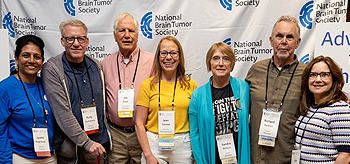Galactic warfare. Robot sidekicks. Time machines. The “Sci-Fi” genre – made famous by the likes of Star Wars, The Terminator, and Dune – has been a staple of American pop culture since the early 20th century.
Beyond epic space battles and advanced civilizations, there’s also a significant corner of science fiction that explores futuristic medical treatments. Star Trek made famous the idea of a portable device that can instantly scan and diagnose any ailment. Star Wars introduced the idea of “Bacta Tanks,” chambers filled with healing liquids. And, recently, both Apple TV’s Severance and Netflix’s Black Mirror examined different concepts involving technological devices implanted directly into the brain. But are advancements like these really so far off in the distant future?
The line between science fiction and scientific fact is beginning to blur fast in the brain tumor research field as researchers seek ever-more innovative ways to make breakthroughs against brain tumors. Indeed, several companies in the portfolio of the Brain Tumor Investment Fund (BTIF) – the venture philanthropy affiliate of the National Brain Tumor Society that invests capital (philanthropic funding from family offices, donor-advised funds, private and corporate foundations and individual donors) in biotechnology, pharmaceutical, and medical device companies developing products to improve the lives of brain tumor patients – are seeking to advance groundbreaking research and futuristic technology that until recently would have sounded like fantasy. Below we detail three.
Alpheus Medical
Alpheus Medical is a company developing what’s known as “sonodynamic therapy” for brain cancer. Simplified, this means using ultrasound waves to help a drug that helps target and kill tumor cells. It would work like this:
- Before surgery, the patient drinks a liquid solution containing a compound called 5-ALA, which accumulates inside cancerous cells in the brain and causes them to become fluorescent.
- Once the tumor cells are loaded up with the 5-ALA, sonodynamic therapy is delivered by applying ultrasound waves via a non-invasive, proprietary device.
- When the ultrasound waves hit the cells full of the 5-ALA, they release a form of oxygen (called an oxygen radical) in the cancerous cells, which causes them to die.
- Finally, the immune system eliminates the broken-down cancer cells from the body.
Alpheus has a great video breaking down the science of sonodynamic therapy on its website.
Through the Brain Tumor Investment Fund (BTIF), we’ve participated in two rounds of funding for Alpheus, helping the company run a phase IIb randomized controlled clinical trial in patients with newly diagnosed glioblastoma (GBM), after announcing positive early results from a phase I/II first-in-human trial.
Cordance Medical
Cordance Medical is a company developing a non-invasive medical device to open the protective blood-brain barrier to help better treat diseases in the brain, including brain tumors.
The blood-brain barrier (BBB) is the brain’s security system. It lets in things the brain needs from the bloodstream (like nutrients and oxygen), and keeps out other potentially harmful substances (like toxins, bacteria, or chemicals). Unfortunately, it blocks most anti-cancer drugs from reaching the brain, too. So Cordance is developing its own novel device to temporarily open the BBB using focused ultrasound waves for just the right amount of time to allow treatments to access the brain. Here’s how it would work:
- A doctor selects the area of the BBB they want to open, based on imaging of the patient’s brain.
- A patient-specific treatment plan is generated and uploaded to the device.
- A “Cordance Cap” is fitted to the patient’s head.
- Tiny, gas-filled “microbubbles” are injected into the bloodstream.
- A harmless low-frequency focused ultrasound beam (like a medical “laser” made of sound) is aimed at the selected area of the brain.
- As the microbubbles pass through the targeted area, the ultrasound causes them to vibrate, gently stretching the lining of the blood vessels in the area.
- The stretching loosens the tight junctions in the blood-brain barrier, opening it just enough for large molecules (like drugs) to pass through to the brain tissue where they’re needed.
- This opening lasts only a few hours, then the barrier reseals itself naturally.
In addition to potentially helping deliver drugs, Cordance hopes to show that its device can also allow tumor biomarkers (analites) to leave the brain for sampling from patients’ bloodstream, known as “liquid biopsy” of brain tumors. In this way, neuro-oncologists can monitor tumor growth, evolution, and response to treatment without having to perform highly invasive brain biopsies over and over. Helpful illustrations of how the treatment would work can be found on the company’s website.
BTIF’s support is helping Cordance as it prepares its device for clinical trials, following encouraging preclinical data.
EnClear Therapies
EnClear Therapies is a company developing a precision drug delivery system that aims to deliver controlled, continuous, and personalized therapy to patients with brain tumors and other brain disorders by safely accessing and uniquely managing patients’ cerebrospinal fluid (CSF).
Like Cordance, EnClear is seeking to address challenges to successful drug delivery for brain tumors presented by the BBB. In its case, EnClear engineered a novel system to deliver therapies into the CSF, bypassing the BBB. The system, called the EnTrega CSF Management Platform, features two brain implants, proprietary software for sensing changes inside the patient’s brain, an AI-based algorithm to monitor and collect real-time data on safety and efficacy measures, as well as automated CSF collection and sampling.
Here’s how EnClear describes how this system would work:
- Unlike single dose, one-way delivery of drugs to targets in the brain, EnTrega CSF creates a communications loop using two implanted catheters, integrated with a dual pumping system to move drugs and CSF around as needed.
- The platform’s precision sensing technology would allow for control of therapeutic dose and CSF flow, direction, and speed.
- With these CSF control systems, Entrega could move a drug to its target tissue and hold it in place so a maximum amount of the treatment is absorbed into the cancerous cells.
- The platform would also be able to obtain samples of clinical biomarkers for monitoring of disease progression.
A video on the EnClear website visualizes these features.
If proven, this could optimize delivery of therapies and thus reduced risk of severe side effects.
Support from the Brain Tumor Investment Fund is helping EnClear further develop its platform preclinically.
These companies and the products they aim to develop represent just a few of the highly innovative, entrepreneurial, and outside-the-box thinkers in the brain tumor field. Across the spectrum of academia, government, and industry, there’s a tangible sense that to defeat brain tumors, researchers need to advance science and technology into the realm of the previously unimaginable. Lipid nanoparticles, gene-editing, cellular and gene therapies (like those being developed by another BTIF portfolio company, Trogenix); implanted microdevices, and cancer “avatars” (similar, also, to work being done by BTIF portfolio company, Kiyatec) – hardly a week goes by when there isn’t report of a new study in the brain tumor space that sounds otherworldly on its surface.
At NBTS and BTIF, we seek to fund, invest in, and support these innovators’ cutting-edge efforts with the hope and goal that in the not-too-distant future any number will prove to be the brain tumor community’s version of scientific fact triumphing over science fiction.


